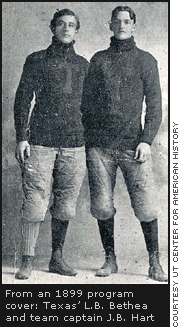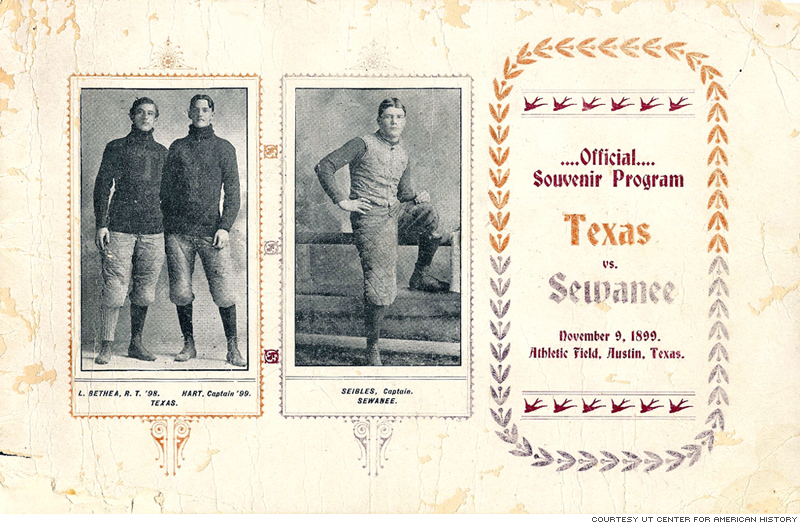1893 - 1899
Although Austin had grown to roughly 15,000 citizens by the fall of 1893, it still felt like a small frontier town-even though it was both the state capital and the home of the state's new flagship university. The University of Texas opened its doors in 1883 with twelve faculty members, four departments and 221 students-58 of whom were women. There was no athletic department. A student-organized baseball club formed by 1885, but its games were mostly local affairs against other Austin teams. From the beginning, however, football had a high profile.
The fall of 1893 was tumultuous. America stood on the brink of economic depression as banks failed throughout the country and hundreds of businesses laid off workers and closed their doors in bankruptcy. On the brighter side of things was the astonishing success of the Chicago World's Fair, which ended its six-month run on October 30th to the general agreement that the "World's Columbian Exposition" had proven that America was a nation of culture, vision and industry that deserved to be considered a world leader. And just across the Red River from Texas, the last great land rush in America's history occurred on September 16, 1893, when the federal government allowed settlers to race to stake claims in Oklahoma's Cherokee Strip. The West, some pundits claimed, was finally closed.
In November of 1893, however, the talk among the small student body at The University of Texas was mostly about the challenge sent down from the Dallas football club. The so-called "Football Champions of Texas" wanted to see what UT's small club could do in a match against them, and were willing to promote a game at the Dallas Fairgrounds against the student-run team. So on Thanksgiving morning, fifteen young men traveled north by train to stake their own claim. The Texas Varsity, as they were called, ended up the victors that day besting the Dallas team 18-16. The UT club played three other games that year, beating San Antonio twice, and Dallas again.
Although some UT baseball fans had worn orange and white ribbons as early as 1885, the football team considered gold and white to be their colors during these early years. As for uniforms, each man provided his own. The program for that first game, located now at the Dolphe Brisco Center for American History, was simply printed on 8 ½ by 11 paper and then folded in half. It was printed by the match organizers, not UT, since the game was not an official university function. The cover design is typical of the elaborate decorative style seen in the height of the Victorian era. Inside that program is simply a list of the players on both teams and the rules for the game, which in that era could vary considerably depending on where the game was being played in America.
Following that first year, two Texas alums donated enough money to the student-run Athletic Association Club that they could hire a coach, R .D. Wentworth, and buy matching uniforms. Under Wentworth's leadership, the team won its first five games in 1894 against "town teams," but was then crushed by the University of Missouri 28-0 in the final game of the season. By 1899, the year of the the Sewanee program, the Texas game had evolved into two twenty-minute halves and an eight-game season, and UT had been through four more coaches.
With the formation of the Athletic Council in 1895, football became an official part of UT, and two years later Mike Kelly was hired to serve as its first full-time coach. Previous coaches had stayed only for the football season, but Kelly had year-round duties as the first Physical Director for Men, a job description that included service as football coach. After one year, however, Kelly concentrated on running the new men's gymnasium built in the east wing of Old Main, and agreed to serve as UT's first assistant football coach. The head coaching position was taken over by Princeton graduate David Farragut Edwards, who led the Longhorns to a 5-1 season in 1898. Their only loss that year was to Sewanee, who beat the Longhorns 4-0. (At this time, a touchdown was worth four points.) The following year found the Longhorns with yet another new coach—Maurice Gordan Clarke—who led the Longhorns to a 6-2 record, losing only to Sewanee (12-0) and Vanderbilt.
The Sewanee program's cover included photographs of the teams' top players, dressed in the heavily quilted pants that were the standard uniform for football in those days. Pictured with the 1899 UT team captain J. B. Hart was right tackle L.B. Bethea. Hart would return to Texas in 1902 as coach, leading the Longhorns to a 6-3-1 record. Also noteworthy about the cover is the location of the game at the "Athletic Field - Austin, Texas." Through 1899, UT's football games were played on a public field located in Hyde Park, which was a good distance from the University. The eight-page Sewanee program includes little more than a roster, score card for the fan to keep his own score, and several local ads for clothing retailers and a pharmacy.





